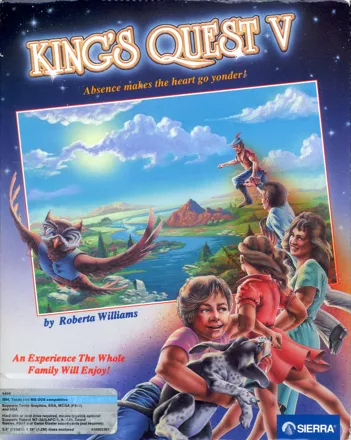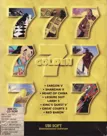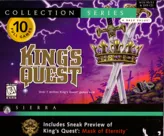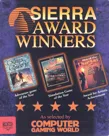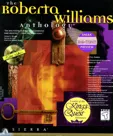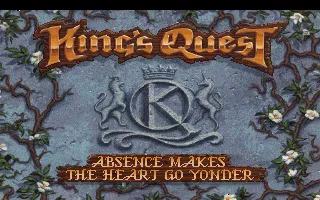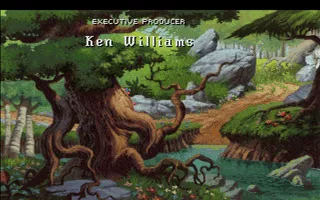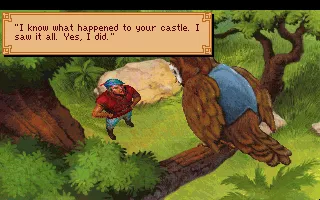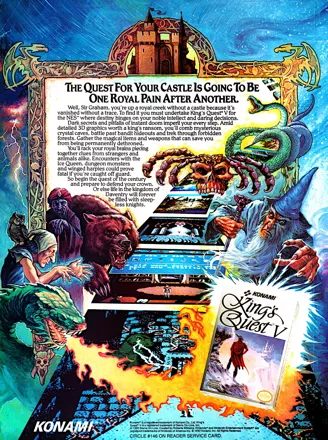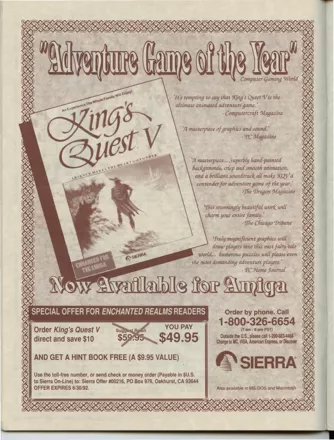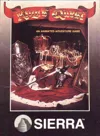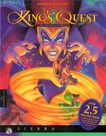King's Quest V: Absence Makes the Heart Go Yonder!
Description official descriptions
On a beautiful sunny day, King Graham of Daventry decides to take a stroll in the woods surrounding his castle. When he returns, he discovers with horror that his home, Daventry Castle, has completely disappeared! Graham is at a loss, and wonders how this could have happened, when a talking owl named Cedric appears. He tells him that he saw the whole thing, and that an evil wizard named Mordack whisked the entire castle away, along with Graham's family in it. Cedric offers to take him to his homeland, Serenia, where his master, the wizard Crispin resides. Surely Crispin will be able to help King Graham rescue his family from Mordack's clutches.
King's Quest V: Absence Makes the Heart Go Yonder is an adventure game, and the first from Sierra to use a point-and-click mouse interface. Rather than typing commands on a keyboard to interact with the game world and use the arrow keys to walk around, King's Quest V instead simplifies all actions down to base commands. To access the different cursors, the player can move the mouse to the top of the screen, revealing a hidden menu with each of the different actions, as well as game options and the inventory bag. By clicking the "Walk" cursor on the screen, Graham will walk as close as he can to the appropriate area. Clicking the "Eye" cursor on items will provide a description, the same as typing "Look at". The "Hand" cursor is a multipurpose cursor that can be used to push, pull, interact with and pick up objects. The "Head" cursor is used to talk to people (and in the strange world of King's Quest, often objects and animals, too). Players can also right-click to cycle through the different available cursors. Inventory that Graham picks up now gets placed into a bag. By clicking on the bag, this opens up a sub-window that displays all the inventory that Graham currently has. In here, players can look at or interact with objects, combine them with other objects, or pick them up to use them in the game environment as another cursor.
As with most Sierra games, it is quite possible to die. Bumping into witches, poisonous scorpions, falling off edges of cliffs, dying of thirst in the desert, and many other objects, locations and characters will send Graham to an untimely demise. The player must be cautious as they explore Serenia - frequent game saving across multiple files is usually the best course of action to make sure that you don't get stuck or have to start right from the game's very beginning.
The NES port of King's Quest V retains the icon-based interface and most of the locations, puzzles, and dialogue from the earlier release. Graphics had to be re-drawn with fewer colors and less detail to fit within the restrictions of the hardware, and the artwork in many areas is different.
This version removes most alternate solutions to puzzles and does not allow many actions that would render the game unwinnable. It also shortens and eliminates several scenes; for example, it is impossible to revisit the wizard in the first house. A few locations (such as the desert) are smaller. Some death sequences have been removed or modified not to include words related to death. Finally, some text descriptions were altered.
Spellings
- キングズ・クエストV - Japanese spelling
- 國王密使 V - Traditional Chinese spelling
Groups +
Screenshots
Promos
Credits (DOS version)
66 People · View all
| Executive Producer | |
| Creative Director | |
| Game Designer | |
| Art Designer | |
| Producer | |
| Lead Programmer | |
| Composers | |
| Documentation | |
| Creative Consultant | |
| Artists | |
| [ full credits ] | |
Reviews
Critics
Average score: 78% (based on 26 ratings)
Players
Average score: 3.8 out of 5 (based on 135 ratings with 12 reviews)
King's Quest V is a major turning point for Sierra
The Good
King's Quest V is Sierra's first major departure from their text parser adventure game interface. The primary new feature is the icon system to allow the player to interact with the world, and it was (and still is) a controversial change.
Backgrounds are no longer computer artwork in KQ5, but nicely scanned oil paintings in 256 colors. They look fantastic and work quite well, furthering the "storybook" theme. However, the sprite animation is similar to previous Sierra games. The music is also very nice and there is support for many sound cards. Sound effects are minimal, but the new multimedia CD-ROM version features voice acting -- another first for Sierra.
The plot is decent, although I don't care for the introduction.
The Bad
The mouse interface had its good and bad points. Although it allowed the game to possibly reach a much wider audience, the icons really did reduce the amount of detail that was put into the setting. Fortunately, the new graphics help to offset this to some degree. Also, some of the icons are rarely needed and just take up space. This was rectified in later games.
While the new interface makes KQ5 easier to play, it does not necessarily make the puzzles much easier. Some are challenging, and I could not get through the game the first time without a couple of hints. Beware, like most "classic" adventure games, it is also possible to make mistakes in a few places such that you can not finish the game!
Furthermore, there isn't much replayability in this title. The puzzles are solved in one way, and although you can travel around a bit, most puzzles are also solved in a linear fashion. Oddly enough, I replayed it a few times; on repeat, it seems like a different game if you have struggled through the first time.
Getting back to the graphics, they are quite good in VGA. I also played the EGA version, and I can say it was UGLY -- much worse than any of Sierra's 16 color games of the era. They simply took the 256 color images and reduced them to 16 colors and the results were terrible. The only thing worse was the console version.
The final complaint is the box size. Sierra left their traditional box size, which was small by industry standards, and blew it up to a thick monstrosity. Most other publishers that hadn't done this this quickly followed suit, and this wasn't brought back under control until the time of this review, 2002.
The Bottom Line
King's Quest V is a classic adventure game that marks a turning point in the genre. Many questioned whether some of the changes were for the better. In any case, it turned out to be a huge hit, and is definitely worth playing through once.
DOS · by vni VIC (19) · 2002
The Good
Gamers may have to be of a certain age in order to fully appreciate the technical wonder that is King's Quest V: Absence Makes the Heart Go Younder!.
Early adventure games -- Sierra has a major player in the genre -- were initially text-only quests. Much like the days of classic radio dramas, these early computer games required the player to use his imagination (and typing skills) in order to advance in a world that only existed through on-screen text.
Gradually, adventure games began to feature CGA and EGA-style graphics to create the characters, items, puzzles and locations that the player had to interact with.
It would be wrong to dismiss CGA/EGA graphics outright as hopefully archaic.
However, it was not really into the jump to VGA graphics that computer games -- especially adventure games -- could really create a environment that look more like an epic cartoon or painting, as opposed to something that (for lack of a better word) "looked" like a computer game.
King's Quest V was the first game in the series to make the jump to the superior VGA graphics. The result is a an epic adventure game set in a lush and beautiful game environment.
VGA graphics may not impress younger generations of gamers, but (in 1990) it was simply incredible to play an adventure game with VGA graphics and marvel at the game's artwork and character design.
King's Quest V also shinned in the audio department, and (while other gamers may disagree) I enjoyed the transition into more point and click, icon-based game play mechanics.
Sierra did not skimp on the storyline in King's Quest V. King Graham is about to return to his castle (after talking a lovely walk), only to see his castle (and all his family members) whisked away by an evil wizard.
As is the case with the previous King's Quest entries, the game manages to put a creative spin on familiar fantasy elements, and quests often require you to help out other creatures (large and small).
Story elements from previous King's Quest games are smoothly brought into the part V and (interestingly enough) certain events in part 5 are further developed in King's Quest VI.
Overall, it is hard to find too many odious faults with King's Quest V. Hard, but not impossible.
The Bad
The groundbreaking nature of King's Quest V's graphics and music can easily be lost on younger gamers.
In the 1990s, VGA was superceded by SVGA. Computer disks were superceded by CD-ROM technology.
As popular as King's Quest V was in 1990, it didn't have as much of a long-lasting impact on the adventure gaming genre as did say, Alone in the Dark (1992).
Alone in the Dark (1992) was released a few years after King's Quest V, and it represented a significant shift in the look and design of adventure games.
Where as King's Quest V represented the advances in classic adventure gaming, games like Alone in the Dark (1992), "Tomb Raider" (1996) and "Resident Evil" (1996) represented a successful mutation or spinoff within the adventuring gaming genre.
Younger gamers are probably more familiar with the spinoff and its tropes. These spinoff adventure game environments were "3D" with pre-rendered (if not polygon) graphics. Success required action-packed blistered thumbs (often within the real of survival horror) as well as solving item-based puzzles.
I am not suggesting that the "new" style of adventuring gaming is better or worse then the more traditional style.
Rather, the fact that King's Quest V is a great classic adventure game, may make it harder for some gamers to appreciate the game fully.
Younger games have some different expectations about what makes a great adventure game, in comparison to people that played King's Quest V (when it was first released) while in middle or high school.
The Bottom Line
King's Quest V: Absence Makes the Heart Go Younder! is a great, classic adventure game, as well as a great entry in the King's Quest gaming franchise. Gamers of every generation who can appreciate the classics, should be able to love this game.
DOS · by Edward TJ Brown (118) · 2015
The Good
King's Quest V: Absence Makes the Heart Go Yonder (1990) was a fabulous entry into the already groundbreaking point n' click graphic adventuring franchise. Not only did it feature a long and detailed fantasy themed quest, with plenty of new puzzles, personalities and locations, but it also dazzled us with incredible graphics and sound, which had not been seen before on a personal computer.
The NES version of King's Quest V (1992) offer most of the elements that made the computer game successful; i.e. the same fantasy themed locations, items, puzzles, personalities, etc.
It was rare for a graphic adventure computer games to make the jump onto a home console system and it is nice to be able to play a classic adventure game, without having to master DOS or own an upscale (circa 1990) personal computer.
The Bad
The 8-bit NES simply could not recreate the same high quality animation, graphics, music and sound effects created on the personal computer. What was groundbreaking for the computer, was simply not possible for the NES.
For the NES, the game's animation and graphics are all very impressive, although some items are difficult to see and the quality of background and character detail does very greatly. Yet, it is nowhere near the same experience as playing King's Quest V on the computer.
The music and sound effects are a bit of a disappointment; both in comparison to the computer and even the abilities of the 8-bit Nintendo. When they do exist, the music and sound effects are generally best left on mute.
While the later PC CD-ROM edition of King's Quest added voice talents to read the script, such a feature was simply not possible on the Nintendo, which means that you need to be ready to read lots and lots of on-screen text and [to save your progress] write down very long passwords.
Reading the instruction manual will be a requirement because there is no mouse option. You will need to learn how to cycle between the various icon commands and then use the keypad to move the on-screen arrow to the item or person in question.
The Bottom Line
King's Quest V: Absence Makes the Heart Go Yonder (1992) offers a long and, generally, enjoyable fantasy-themed, point n' click, graphic adventure game for the 8-bit NES. The original storyline is intact, along with the original computer game's characters, locations, puzzles and item inventory.
Gamers who played the game on the personal computer when it originally came out or even the re-release on CD-ROM, may be unable to get past the hardware limitations of the 8-bit Nintendo.
However, not many point 'n click, graphic adventure games were made for the 8-bit Nintendo and this is certainly an ambition game. Fans of the adventuring gaming genre, who can look past the hardware limitations, should give this game a try.
NES · by ETJB (428) · 2023
Discussion
| Subject | By | Date |
|---|---|---|
| Color number in the Amiga version | Nowhere Girl (8680) | Aug 15, 2014 |
| Game freezing | Nowhere Girl (8680) | Jul 27, 2012 |
Trivia
A rare "king" game in the series
Despite the title of the series, there are only two installments where you actually play as a king (namely, King Graham): this one and King's Quest II.
CD version
The game was also released on CD-ROM. This CD version had full speech throughout the game.
Innovations
King's Quest V was the first adventure game to be released on CD-ROM in MPC (Multimedia PC) format, the first to have digitized voiceovers, the first to use digitized hand painted backgrounds, and the first title to cost over one million U.S. dollar to produce.
Installation
Installing the game on the PC was less intuitive than other Sierra releases due to the variety of options supported. An addendum to the manual was included which attempted to explain all of the installation options. The game could be played entirely from hard disk, half from hard drive and half on floppy, or entirely on floppy if two drives were present. If you were playing with one 3.5" drive and one 5.25" drive, installation began on either 5.25" disk #6 or 3.5" disk #10. All other combinations began installation on 5.25" disk #5 or 3.5" disk #9. (confused yet? King's Quest V may also be the only Sierra title where installation doesn't begin with either disk #1 or the Startup disk.) Probably in the interest of simplicity, media cost, and sanity most (if not all) of Sierra's later games shipped with just one set of disks per package eliminating the ability to play entirely from floppy but simplifying installation.
User interface
The first game in the King's Quest series (in fact, all classic Sierra adventures) to switch to icon control from the text parser system.
Versions
King's Quest V was the first Sierra game to be available in two separate versions: a 16 color version (supporting EGA, MCGA, VGA, and Tandy/PCjr graphics) and a 256 color version (supporting MCGA and VGA only). The 16 color version came with 10 3.5" DD disks and 6 5.25" HD disks. 5.25" DD (360k) disks could be ordered directly from Sierra. (A hard disk was required to use the 360k disks.)
Awards
- Computer Gaming World
- March 1992 (Issue #92) – Introduced into the Hall of Fame
- November 1991 (Issue #88) – Adventure Game of the Year
- November 1996 (15th anniversary issue) - #94 in the “150 Best Games of All Time”
- GameStar (Germany)
- Issue 12/1999 - #94 in the "100 Most Important PC Games of the Nineties" ranking
Information also contributed by Adam Baratz, Mitch Kocen, PCGamer77, Roger Wilco, Sciere and Servo
Analytics
Upgrade to MobyPro to view research rankings!
Related Sites +
-
Hints for KQ5
Wonderful question and answer hints will get you through the game at your own pace.
Identifiers +
Contribute
Are you familiar with this game? Help document and preserve this entry in video game history! If your contribution is approved, you will earn points and be credited as a contributor.
Contributors to this Entry
Game added by Andy Roark.
Amiga added by POMAH. NES added by totalgridlock. Windows 3.x added by ZZip. PC-98, Macintosh, FM Towns added by Terok Nor.
Additional contributors: Katakis | カタキス, Jeanne, Chentzilla, Xoleras, Игги Друге, Paulus18950, Patrick Bregger, Kayburt.
Game added May 23, 1999. Last modified February 13, 2024.
